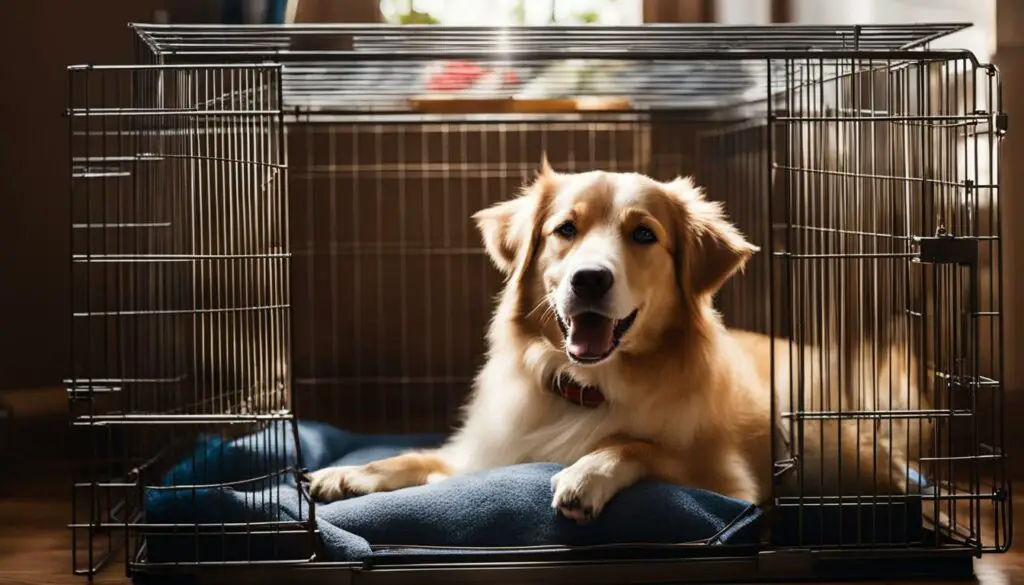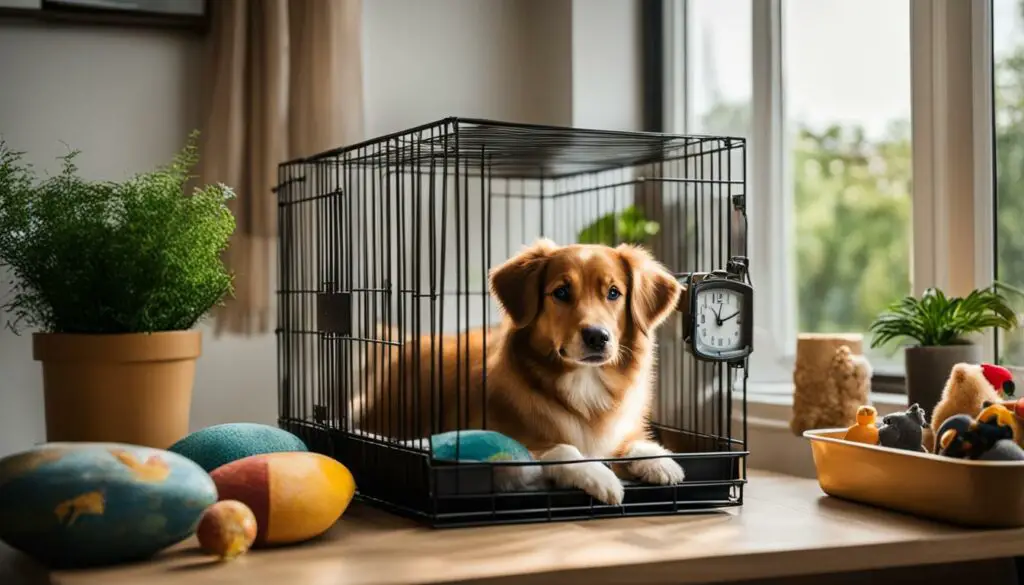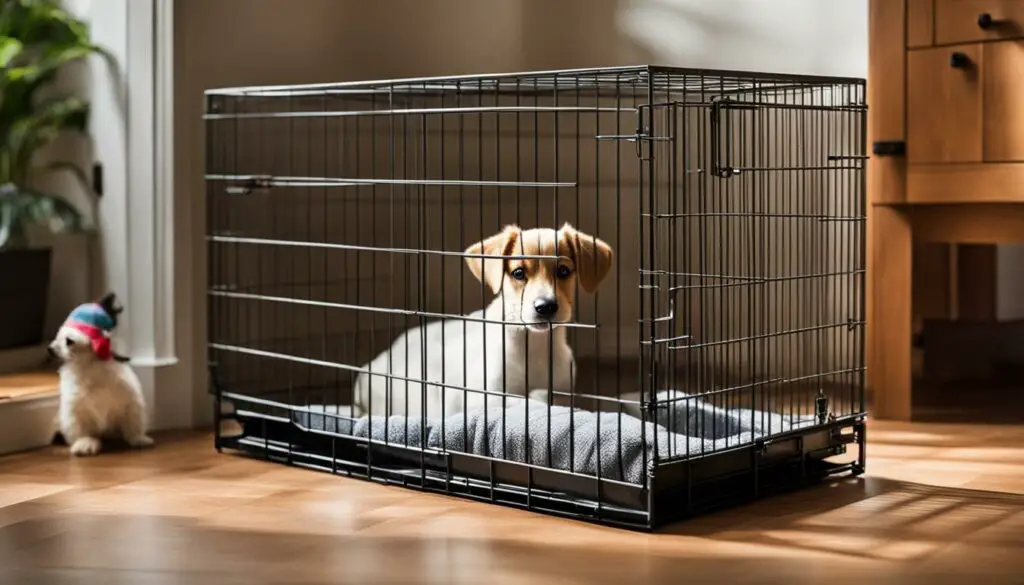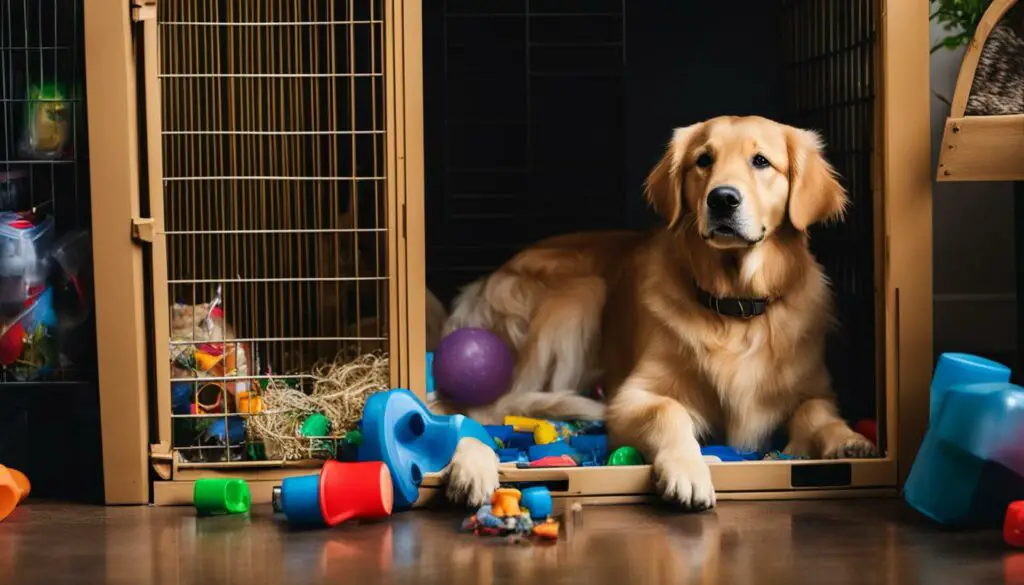Are you leaving your dog in a crate for 8 hours? It’s important to understand the effects that extended crate time can have on your furry friend. While crate training can be beneficial for dogs, overusing the crate or crating for too long can lead to behavior problems and undermine the effectiveness of the training.
Let’s take a closer look at the benefits of crate training, the recommended crate time for puppies and adult dogs, the risks of overusing the crate, helpful crate training tips, and factors to consider when determining crate time for your dog.
Key Takeaways:
- Leaving your dog in a crate for too long can cause behavior problems and undermine crate training effectiveness.
- Crates can help dogs feel secure, aid in potty-training, and calm hyperactive dogs.
- Puppies should have shorter crate time compared to adult dogs due to smaller bladders.
- Most adult dogs can handle being crated for about half a day, but longer periods can lead to behavioral issues.
- Overusing the crate can cause dogs to resent it and develop aggression or health problems.
The Benefits of Crate Training for Dogs
When it comes to crate training, there are several benefits that both dogs and their owners can enjoy. Crate training provides a safe and secure space for dogs, allowing them to feel more comfortable and calm. It can also aid in potty-training, as dogs have a natural instinct to keep their sleeping area clean. By utilizing the crate as a tool, owners can establish a routine and teach their dogs to hold their bladder until they are outside.
Another advantage of crate training is its ability to help hyperactive dogs relax. The confined space of the crate can act as a den, providing a sense of security and reducing anxiety. This is particularly beneficial for dogs that struggle with separation anxiety, as the crate becomes a soothing environment in their owner’s absence.
However, it’s important to note that crate training should be used in conjunction with playtime, exercise, and training sessions. Dogs should not be left in a crate for extended periods without breaks. It’s crucial to strike a balance and avoid overusing the crate, as this can lead to behavioral problems. By incorporating crate training as part of a well-rounded routine, dogs can experience the benefits while maintaining their overall well-being.

Crate Training Benefits
- Provides a safe and secure space for dogs
- Aids in potty-training by establishing a routine
- Helps hyperactive dogs relax and reduces anxiety
- Can assist in managing separation anxiety
By understanding the benefits of crate training and implementing the appropriate techniques, dog owners can create a positive and effective training experience for their furry friends.
Crate Time for Puppies
When it comes to crate training puppies, it’s important to establish a proper schedule to ensure their well-being and comfort. Puppies have smaller bladders and may not be able to hold their urine for extended periods of time. According to the Humane Society, puppies under six months old should not be left in a crate for longer than three to four hours.
Keeping a close eye on your puppy’s behavior is crucial during crate training. By gradually increasing crate time as they grow, you can help them build positive associations with their crate. Start with short periods of crate time, and gradually extend the duration as they become more comfortable.
To ease separation anxiety, it’s important to make the crate a safe and inviting space. Include their favorite toys, a cozy blanket, and even an item with your scent to provide reassurance. By establishing a routine that includes regular potty breaks, feeding times, and play sessions outside of the crate, you can help your puppy feel secure and adjust to crate training more easily.
| Puppy Age | Recommended Crate Time |
|---|---|
| 8-10 weeks | 30-60 minutes |
| 3-6 months | 1-3 hours |
| 6-12 months | 3-6 hours |
Remember, crate time for puppies should be balanced with plenty of socialization, exercise, and mental stimulation outside of the crate. By providing a loving and nurturing environment, you can help your puppy develop into a well-adjusted adult dog.
Crate Time for Adult Dogs
When it comes to crate training adult dogs, the amount of time they can be crated depends on various factors such as their age, health, size, and previous crate training experience. Most healthy adult dogs can handle being crated for about 4-6 hours at a time, as long as they receive sufficient exercise and mental stimulation when they are out of the crate. However, crating a dog for longer than this can often lead to behavioral problems and negatively impact their well-being.
It is important to consider the specific needs of your dog when determining their crate time. Factors such as the dog’s activity level and breed can play a role in how long they can comfortably stay in a crate. For example, higher energy breeds may require more frequent breaks and exercise to prevent restlessness and anxiety. On the other hand, senior dogs may have decreased bladder control and may need shorter crate times.
As a responsible dog owner, it is crucial to prioritize the welfare of your dog and ensure that their time in the crate is safe and comfortable. If you find yourself needing to crate your dog for longer periods due to work or other commitments, it is recommended to hire a dog walker or consider doggy daycare to provide them with the necessary exercise and stimulation they need throughout the day.
| Age | Recommended Crate Time |
|---|---|
| Adult Dog | 4-6 hours |
| Senior Dog | 2-4 hours |
Remember, the crate should never be used as a form of punishment, and it is essential to provide positive reinforcement and rewards during the crate training process. Gradually introducing your dog to the crate and associating it with positive experiences will help them see it as a safe and comfortable space. By finding the right balance and considering your dog’s individual needs, you can ensure that crate time for adult dogs is a positive and beneficial experience for both you and your furry friend.
Risks of Overusing Your Crate
While crate training can be a valuable tool for dog owners, overusing the crate can have negative effects on your furry friend. It’s important to find the right balance and avoid relying too heavily on the crate for extended periods of time. Let’s explore the risks associated with overusing the crate and how to ensure a positive training experience for your dog.
Behavioral Problems
Overusing the crate can lead to behavioral problems in dogs, including aggression issues and separation anxiety. Dogs may start to resent the crate if they associate it with being confined for long periods, leading to negative behaviors when they are in the crate or even when they are outside of it. It’s crucial to use the crate as a positive tool and never as a form of punishment to prevent these behavioral problems from arising.
Health Concerns
Over-crating can also have negative effects on your dog’s physical health. Dogs that are crated for excessive amounts of time may develop joint and muscle problems from lack of movement. They may also experience increased stress, which can lead to weakened immune systems and a higher risk of developing illnesses. Ensuring that your dog gets enough exercise and mental stimulation outside of the crate is essential for their overall well-being.
| Risks of Overusing Your Crate | Prevention |
|---|---|
| Behavioral Problems (aggression, separation anxiety) | Use the crate as a positive tool, provide alternative forms of confinement, and gradually increase crate time. |
| Health Concerns (joint and muscle problems, weakened immune system) | Ensure your dog gets regular exercise and mental stimulation outside of the crate, and limit crate time to appropriate durations. |
Remember, the crate should be seen as a safe and comfortable space for your dog, not as a long-term solution for confinement.
Alternatives to Overusing the Crate
If you find that you need to leave your dog for extended periods of time and cannot provide them with enough exercise and attention, there are alternatives to consider. Hiring a dog walker to take your dog for walks or enrolling them in doggy daycare can provide the necessary socialization and stimulation that they need. These alternatives can help prevent the overuse of the crate and promote a well-balanced lifestyle for your furry friend.
By understanding the risks associated with overusing the crate and taking steps to prevent them, you can ensure a positive and effective crate training experience for your dog. Remember to use the crate as a tool in conjunction with other training methods and provide your dog with ample exercise, mental stimulation, and socialization to promote their overall well-being.

Crate Training Tips
To maximize the effectiveness of crate training, there are several tips and techniques that can be helpful. Here are some recommendations:
- Choose the right location: Place the crate in an area of your home where your dog feels comfortable and secure. It should be a quiet space, away from any distractions or noise.
- Introduce the crate gradually: Allow your dog to explore the crate at their own pace. Start by leaving the door open and placing treats or toys inside to create a positive association. Gradually encourage your dog to enter the crate and reward them for doing so.
- Ensure the right crate size: The crate should be large enough for your dog to stand up, turn around, and lie down comfortably. However, it should not be too big, as this may encourage your dog to use one end as a bathroom. Choose a crate that is the appropriate size for your dog’s breed and weight.
“Crate training should be a positive experience for your dog. Take the time to make the crate a comfortable and inviting space.”

Never use the crate as a form of punishment: The crate should always be associated with positive experiences. Avoid using it as a place of confinement or timeout. Instead, provide your dog with plenty of praise, treats, and rewards when they enter or stay in the crate.
Establish a routine: Dogs thrive on routine, so it’s important to establish a consistent schedule for crate time. This includes regular feeding, bathroom breaks, exercise, and playtime. By following a routine, your dog will learn to anticipate and feel more comfortable in their crate.
By following these crate training tips and techniques, you can create a positive and effective crate training experience for your dog. Remember to be patient and provide plenty of praise and rewards throughout the process. With time and consistency, your dog will learn to view the crate as a safe and comfortable space.
Factors to Consider When Determining Crate Time
When deciding how long to crate your dog, there are several factors to consider. These factors include your dog’s age, health, size, and previous crate training experience. By taking these factors into account, you can determine an appropriate crate time that meets your dog’s needs.
Dog’s Age: Puppies have smaller bladders and less control over their bladder muscles, so they need more frequent potty breaks. The Humane Society recommends that puppies under six months old should not be left in a crate for longer than three to four hours. As they grow older and their bladder control improves, you can gradually increase their crate time.
Dog’s Health: Dogs with certain health conditions may require shorter crate times. For example, senior dogs may have decreased bladder control and may need to be let out more frequently. It’s important to consult with your veterinarian to determine the appropriate crate time for a dog with specific health needs.
Dog’s Size: The size of your dog can also impact how long they can comfortably stay in a crate. A larger dog may need a crate with more space to move around, while a smaller dog may feel more secure in a cozy crate. It’s important to choose the right crate size for your dog to ensure their comfort and safety.
| Dog’s Age | Recommended Crate Time |
|---|---|
| Puppy (8-10 weeks) | 30-60 minutes |
| Older Puppy (3-6 months) | 1-3 hours |
| Adolescent Puppy (6-12 months) | 3-6 hours |
| Healthy Adult Dog | 4-6 hours |
| Senior Dog | 2-4 hours |
Remember, these are general guidelines and may vary depending on your dog’s specific needs. Observing your dog’s behavior and gradually increasing crate time can help you find the ideal balance.
The Recommended Crate Time Guidelines for Puppies
When it comes to crate training puppies, it’s important to gradually introduce them to the crate and establish a routine. The appropriate crate time for puppies varies based on their age, bladder control, and level of separation anxiety. Here are the recommended crate time guidelines:
| Puppy Age | Recommended Crate Time |
|---|---|
| 8-10 weeks | 30-60 minutes at a time |
| 3-6 months | 1-3 hours in the crate |
| 6-12 months | 3-6 hours in the crate |
Young puppies, between 8-10 weeks old, should only be crated for short periods of time, ideally between 30 to 60 minutes at a time. This timeframe allows for regular potty breaks and prevents them from becoming too anxious or distressed in the crate. As puppies grow older, their bladder control improves, allowing them to handle longer crate times.
For puppies between 3-6 months old, it’s recommended to gradually increase crate time to 1-3 hours. This enables them to adapt to spending more time in the crate while still avoiding accidents. By the time puppies reach 6-12 months of age, they can typically handle crate times of 3-6 hours.
Remember, these guidelines are approximate and can be adjusted based on your specific puppy’s needs. It’s crucial to monitor their behavior and gradually increase crate time as they become more comfortable. Additionally, provide plenty of mental and physical stimulation when they are out of the crate to ensure a balanced and fulfilling day for your puppy.

Tips for Successful Crate Training
- Introduce the crate gradually, allowing your puppy to explore it at their own pace.
- Make the crate a comfortable and inviting space by adding soft bedding and toys.
- Never use the crate as a form of punishment. It should be associated with positive experiences.
- Provide rewards and praise when your puppy enters the crate or remains calm inside.
- Establish a consistent routine for potty breaks and feeding times.
- Consider using crate training as a part of a larger training program that includes positive reinforcement techniques.
Recommended Crate Time Guidelines for Adult Dogs
When it comes to crating adult dogs, it’s important to consider their individual needs, health, and activity levels. While healthy adult dogs can handle being crated for around 4-6 hours, longer periods can lead to behavioral problems. Factors such as breed, size, and bladder control also come into play.
For senior dogs, it’s essential to be mindful of their decreased bladder control. Crate times for these dogs should be shorter, ranging from 2-4 hours. Providing regular potty breaks and monitoring their comfort is crucial to their well-being.
The Activity Level Factor
When determining crate time for adult dogs, their activity levels should be taken into account. High-energy breeds may have a harder time being crated for extended periods without becoming restless or anxious. These dogs may require more frequent breaks and ample exercise when they are out of the crate.
The Importance of Alternatives
If you find yourself needing to crate your adult dog for longer periods, it’s essential to consider alternatives such as hiring a dog walker or considering doggy daycare. These options provide the necessary stimulation and interaction that dogs need to thrive, even when you’re away.

| Age | Crate Time |
|---|---|
| 8-10 weeks | 30-60 minutes |
| 3-6 months | 1-3 hours |
| 6-12 months | 3-6 hours |
| Adult (healthy) | 4-6 hours |
| Senior | 2-4 hours |
Remember, crate time should be balanced with exercise, mental stimulation, and other activities that cater to your dog’s overall well-being. The goal is to create a safe and comfortable environment that promotes positive behavior and addresses your dog’s individual needs.
Strategies for Safe and Comfortable Crate Time
When it comes to ensuring a safe and comfortable experience for your dog during crate time, there are several strategies you can implement. First and foremost, it’s crucial to choose the right crate size for your dog. The crate should be spacious enough for them to stand, turn around, and lie down comfortably. A cramped crate can cause discomfort and anxiety.
In addition to crate size, providing comfortable bedding and toys can make the crate a more inviting space for your dog. Soft bedding can help them relax and feel cozy, while engaging toys can provide mental stimulation during crate time. Remember to choose toys that are safe and suitable for unsupervised use.
Proper ventilation and temperature control are also important factors to consider. Ensure that the crate is well-ventilated to prevent overheating, especially during warmer months. Likewise, during colder months, you may want to place a cozy blanket or cover over the crate to provide additional warmth.
“The comfort and safety of your dog during crate time should be a top priority. Providing the right crate size, comfortable bedding, and engaging toys will help make the experience positive and enjoyable for your furry friend.”
Last but not least, regular exercise and mental stimulation play a crucial role in keeping dogs calm and preventing boredom. Prioritize daily exercise and interactive play sessions outside of the crate to help your dog expend energy and stay mentally stimulated. A tired dog is more likely to relax and enjoy crate time.
| Strategies for Safe and Comfortable Crate Time: |
|---|
| Choose the right crate size |
| Provide comfortable bedding and toys |
| Ensure proper ventilation and temperature |
| Regular exercise and mental stimulation |
By implementing these strategies, you can create a positive and comfortable crate experience for your dog. Remember that gradual crate training and establishing a routine for potty and feeding breaks are also key components of successful crate training. With patience and consistency, your dog can learn to view the crate as a safe and secure space.
The Theory Behind Crate Training
Crate training is a widely used method for training dogs and is based on the theory that it mimics a wild dog’s natural instinct to seek out a den for safety and comfort. Dogs are believed to have a natural affinity for enclosed spaces that provide them with a sense of security. Thus, spending time in their crates can evoke feelings of safety and can be a positive experience for them.
According to this theory, crates can also prevent destructive behavior by confining dogs to a small, safe space when owners are away. By providing a designated area for rest and relaxation, crates can help dogs feel calm and reduce anxiety. Additionally, crates can aid in potty-training by creating a structured routine for bathroom breaks.
While the theory behind crate training is well-established, it is important to note that every dog is unique and may respond differently to crate training. Some dogs may take to the crate quickly and find comfort in it, while others may require more patience and training to become accustomed to the crate. It is essential to introduce the crate gradually and associate it with positive experiences, such as treats and toys, to create a positive association with the crate.

The Benefits of Crate Training
| Benefits | Description |
|---|---|
| Security | Crates provide dogs with a safe and secure space, mimicking their natural instinct to seek out a den. |
| Calmness | The confined space of a crate can help calm hyperactive dogs and provide a sense of comfort and serenity. |
| Potty-training | Using a crate can establish a structured routine for potty breaks, aiding in the potty-training process. |
| Preventing destructive behavior | Crating dogs when owners are away can prevent them from engaging in destructive behaviors, such as chewing furniture or belongings. |
“Using a crate can establish a structured routine for potty breaks and prevent destructive behavior, while also providing dogs with a safe and secure space.”
Choosing the Right Crate for Crate Training
When it comes to crate training your dog, choosing the right crate size is crucial for their comfort and safety. The crate should be spacious enough for your dog to stand, turn around, and lie down comfortably. A crate that is too small can make your dog feel cramped and anxious, while a crate that is too big may not provide the secure, den-like feeling that dogs naturally seek. Taking the time to measure and select the appropriate crate size is an important step in the crate training process.
There are a few factors to consider when determining the right crate size for your dog. First, you’ll need to measure your dog’s height from the floor to the top of their head and their length from the tip of their nose to the base of their tail. Add a few inches to these measurements to ensure your dog has enough room to move comfortably.
It’s also important to take into account your dog’s breed and growth potential. If you have a puppy, consider choosing a crate that is large enough to accommodate their adult size. You can use divider panels or rent a crate to gradually increase the size as your puppy grows. For larger breeds, a crate with higher ceilings and more floor space may be necessary.
| Breed | Adult Size | Ideal Crate Size |
|---|---|---|
| Chihuahua | Up to 6 pounds | 18″L x 12″W x 14″H |
| Labrador Retriever | 55-80 pounds | 42″L x 28″W x 30″H |
| German Shepherd | 50-90 pounds | 48″L x 30″W x 32″H |
Remember, the crate should be a comfortable and secure space for your dog. Adding a cozy bed or blanket, along with a few favorite toys, can help create a positive association with the crate. Gradually introducing your dog to the crate and using positive reinforcement techniques, such as treats and praise, can also help make crate training a positive experience for both you and your furry friend.
How to Crate Train a Dog
When it comes to crate training your dog, it’s important to make the experience positive and comfortable. Here are some crate training tips and techniques that can help.
1. Introduce the crate gradually
Start by placing the crate in a location where your dog feels safe and comfortable. Leave the crate door open and allow your dog to explore it at their own pace. You can also try feeding your dog their meals near the crate to create positive associations.
2. Associate the crate with positive experiences
Use treats, toys, and praise to reward your dog for entering and staying in the crate. Make sure to provide a soft and comfortable bedding to make it more inviting. Using a familiar blanket or item with your scent can also help your dog feel more at ease.
3. Gradually increase crate time
Start by having your dog spend short periods of time in the crate while you’re at home. Gradually increase the duration as your dog becomes more comfortable. Remember to provide mental stimulation with toys or puzzle games during crate time to keep your dog occupied and prevent boredom.
Remember, crate training should never be used as a form of punishment. It’s important to be patient and consistent throughout the training process. By following these crate training tips and techniques, you can create a positive and comfortable crate experience for your dog.

Common Problems with Crate Training
While crate training can be an effective tool for dog owners, there are some common problems that may arise during the process. Understanding these challenges and knowing how to address them can help ensure a successful crate training experience for both you and your furry friend.
Whining and Barking
One of the most common issues with crate training is whining or barking while the dog is in the crate. This behavior can be a sign of separation anxiety or discomfort. It’s important not to scold or punish your dog for whining, as it may increase their anxiety and make the problem worse. Instead, try to gradually acclimate your dog to the crate by introducing it slowly and providing positive reinforcement when they enter or remain calm inside.
Leaving a Puppy in the Crate for Too Long
Puppies have smaller bladders and may not be able to hold their bathroom needs for extended periods. Leaving a puppy in the crate for too long can lead to accidents and may hinder their potty-training progress. It’s essential to establish a regular schedule for crate time and provide frequent potty breaks for young puppies. As they grow older and gain better bladder control, the crate time can be gradually extended.
Using the Crate as a Punishment
Using the crate as a form of punishment can create negative associations for your dog. They may start to view the crate as a place of confinement and may become fearful or resistant to entering it. Instead, make the crate a positive and comfortable space for your dog by rewarding them with treats, toys, or praise when they enter willingly. Creating a positive association will encourage your dog to view the crate as their own safe haven.
By being aware of these common problems and addressing them appropriately, you can overcome the challenges of crate training and create a positive and enjoyable experience for your dog.

| Problem | Causes | Solutions |
|---|---|---|
| Whining and Barking | Separation anxiety, discomfort | Gradual acclimation, positive reinforcement |
| Leaving a Puppy in the Crate for Too Long | Small bladder, limited bladder control | Establish a regular schedule, provide frequent potty breaks |
| Using the Crate as a Punishment | Negative association, fear | Reward-based training, positive reinforcement |
How Long Can a Dog Be Crated?
When it comes to crate training, one common question that arises is how long a dog can be crated. The answer to this question can vary depending on the dog’s age, size, and individual needs. While some experts believe that dogs can be crated for the same amount of time they can reasonably delay the urge to go to the bathroom, others argue that crating for extended periods can have negative psychological and physical effects. It is essential to find the right balance and consider the well-being of your furry friend.
One factor to consider when determining crate time is your dog’s age. Puppies have smaller bladders and need more frequent potty breaks. The Humane Society suggests that puppies under six months old should not be left in a crate for longer than three to four hours. As they grow older, you can gradually increase crate time as they develop better bladder control.
| Puppy Age | Maximum Crate Time |
|---|---|
| 8-10 weeks | 30-60 minutes |
| 3-6 months | 1-3 hours |
| 6-12 months | 3-6 hours |
For adult dogs, the general recommendation is to limit crate time to around 4-6 hours. This timeframe allows them to maintain their comfort and physical well-being. However, it’s essential to consider your dog’s specific needs and activity level. Dogs with certain health conditions or senior dogs may require shorter crate times. It’s always best to consult with your veterinarian for personalized advice.
Remember, crate time should not be excessive or used as a way to confine your dog for extended periods regularly. Dogs are social animals and need mental and physical stimulation. If you need to leave your dog alone for long hours, it’s advisable to consider alternative solutions such as hiring a dog walker or enrolling them in doggy daycare to ensure they receive the necessary exercise and companionship.

Key Takeaways
- The duration a dog can be crated depends on various factors such as age, size, and individual needs.
- Puppies have smaller bladders and require more frequent potty breaks, limiting their crate time.
- Adult dogs should generally not be crated for more than 4-6 hours, with consideration for their health and activity level.
- It’s important to find a balance and provide alternative solutions if your dog needs to be left alone for extended periods.
Conclusion
When it comes to crating a dog for 8 hours, it’s important to consider the effects and find the right balance for your furry friend’s well-being. While crates can have benefits such as aiding in potty-training and calming hyperactive dogs, overusing the crate or crating for too long can lead to behavior problems and health issues.
Instead of relying solely on crating, it’s crucial to incorporate other solutions into your dog’s routine. Hiring a dog walker or considering doggy daycare can provide alternative outlets for exercise and socialization during long workdays. This helps prevent boredom and reduces the risk of your dog developing negative behaviors.
Remember, each dog is unique, and their individual needs should be taken into account. Some dogs may handle being crated for longer periods, while others may require shorter crate times. It’s essential to assess your dog’s age, health, size, and previous crate training experience when determining the appropriate crate time.
In conclusion, crating a dog for 8 hours should only be done when necessary and with caution. By providing a balanced approach, using crates effectively as a tool, and incorporating other solutions to meet your dog’s needs, you can create a safe and comfortable environment for your furry companion.
FAQ
Is it okay to leave my dog in a crate for 8 hours?
Leaving a dog in a crate for 8 hours should be approached with caution. It is important to consider the individual needs of the dog and provide alternative solutions such as dog walkers or daycare when necessary.
What are the benefits of crate training for dogs?
Crate training can help dogs feel secure, aid in potty-training, and calm hyperactive dogs. It can also prevent destructive behavior and keep dogs safe while owners are away.
How long should puppies be crated for?
Puppies under six months old should not be left in a crate for longer than three to four hours. As they grow, crate time can gradually be increased.
How long can adult dogs handle being crated?
Most adult dogs can handle being crated for about half a day (4-6 hours), as long as they get ample exercise and walks when they are out of the crate.
What are the risks of overusing a crate?
Overusing a dog’s crate can lead to behavior problems, aggression issues, and health problems. It is important to find the right balance and use the crate as a positive tool.
What are some crate training tips?
To maximize the effectiveness of crate training, place the crate in a location your dog loves, gradually introduce them to the crate, and use positive reinforcement and rewards during the training process.
What factors should be considered when determining crate time?
The ideal crate time for dogs depends on their age, health, size, and previous crate training experience. It is important to tailor the crate time to the specific needs of your dog.
What is the recommended crate time for puppies?
Puppies should have shorter crate periods, gradually increasing as they grow. Young puppies (8-10 weeks) should only be crated for 30-60 minutes at a time, while older puppies (3-6 months) can handle 1-3 hours in the crate.
What is the recommended crate time for adult dogs?
Healthy adult dogs can handle being crated for around 4-6 hours, but longer periods can lead to behavior problems. Senior dogs may require shorter crate times due to decreased bladder control.
How can crate time be made safe and comfortable for dogs?
Choose the right crate size, provide comfortable bedding and toys, ensure proper ventilation and temperature, and provide regular exercise and mental stimulation to keep dogs calm and prevent boredom.
What is the theory behind crate training?
Crate training is believed to mimic a wild dog’s natural instinct to seek out a den for safety and comfort. Dogs enjoy spending time in their crates because it brings up feelings of security.
How do I choose the right crate for crate training?
Choose a crate that is spacious enough for the dog to stand, turn around, and lie down comfortably. Multiple crates or renting a crate for a growing puppy is recommended.
How do I crate train a dog?
Introduce the crate gradually, associate it with positive experiences such as treats and toys, and gradually increase crate time. Feeding meals in the crate and ensuring a happy introduction are important steps in the training process.
What are common problems with crate training?
Common problems include crate training a puppy for too long, whining, and scolding while in the crate. It is important to be patient, avoid using the crate as punishment, and address any issues that arise during the training process.
How long can a dog be crated?
Opinions on how long a dog can be crated vary. It is important to find the right balance and consider the individual needs of the dog, avoiding excessive crate time that can lead to psychological and physical problems.



